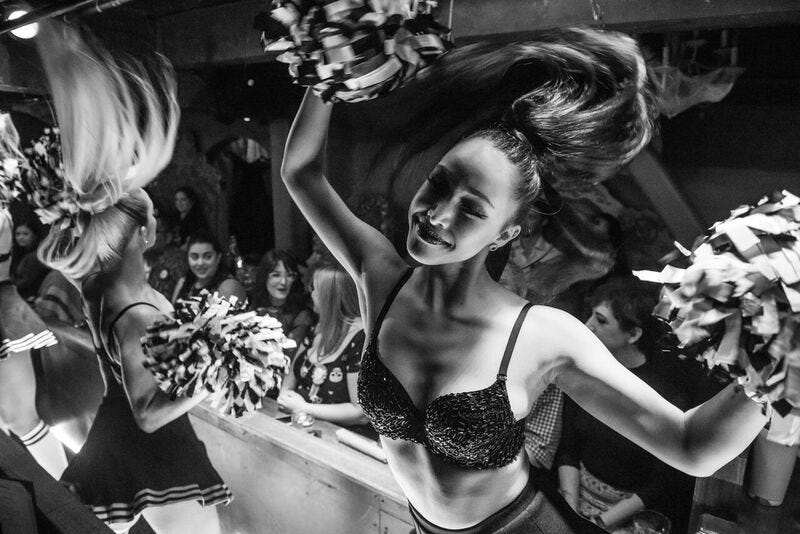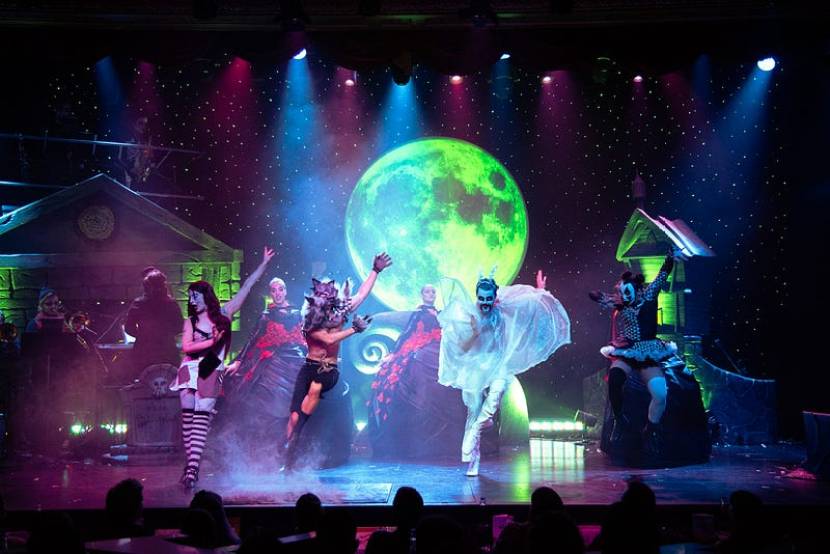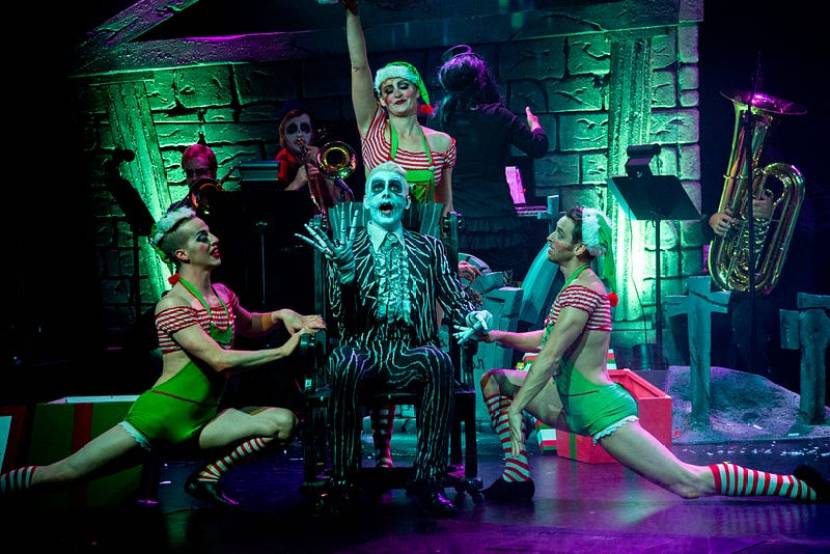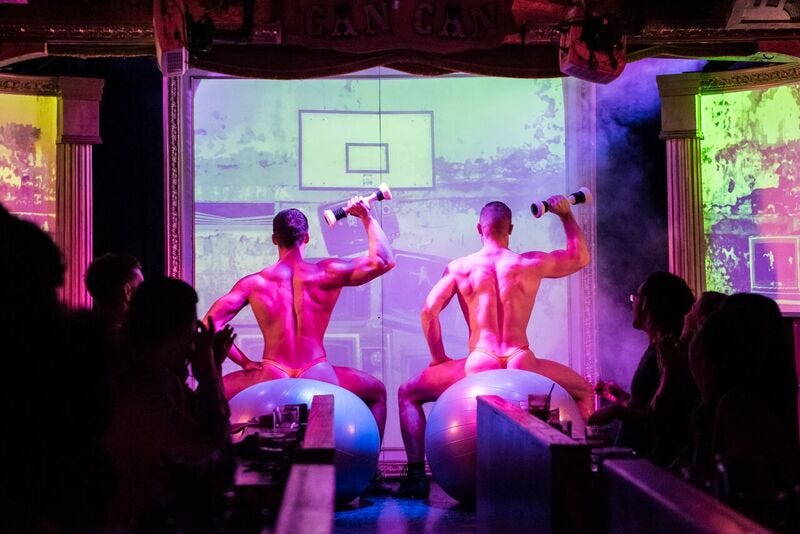Halloween must be the busiest time of year for the staff at the Can Can, the amazing cabaret in Pike Place Market. Putting on over 700 shows a year, the Can Can turns it up to eleven in the tenth month of the year by putting on two fantastic shows: “Zombie Cheerleaders from Hell” at the Can Can, and “This is Halloween” — a cabaret tribute to Tim Burton’s The Nightmare Before Christmas at the Triple Door.
I caught both shows last week and enjoyed myself immensely at each one. “Zombie Cheerleaders” is a fun, raucous, and sexy production that centers around three women and two men on stage at any given moment, in various stages of undress. It turns the small theater into a wild experience with all classically trained dancers. I had no idea until I got there that a show that’s 100% licentiousness was what I needed, but it was great fun. I’m not sure how to properly review a show called “Zombie Cheerleaders from Hell,” so I’ll just add this note: When I got home, here’s how my conversation with my girlfriend went: “Did you get pulled up on stage, like the last time we were at the Can Can?” Me: “No, but I was serenaded by the hunky male dancer.” Her: “Were there no women in the audience?” Me: “There were two bachelorette parties!” Her: “Oh, that’s hilarious.”
“This is Halloween” is a more structured and elaborate narrative production inspired by, as I mentioned above, The Nightmare Before Christmas. It’s also a lot of fun and uses the larger Triple Door room to its full potential by spending a large chunk of the show in the crowd. The costumes and dance routines are first rate. If “Zombie Cheerleaders” is a fun night out free of inhibitions, “This is Halloween” is a date night personified.
To learn more about these two disparate — but self-referential! — shows, I sat down with Can Can artistic director Chris Pink, a couple of days before “This is Halloween” opened.

So you’re putting on two shows at The Triple Door and at the Can Can. So what’s that like doing both of those?
It’s kind of tricky. We finally figured it out. It’s taken us a long time to kind of get these things situated because one, it requires so many human resources, and obviously a ton of planning because we have both limited space, limited time. It’s a giant undertaking. So how we do it is we essentially prepare one of our shows far in advance and then we push this one because we have many repeat dancers.
We kind of push this one (“This is Halloween”) a little bit later and they kind of backup to one another. But it’s always great fun. It’s amazing because these are also times that we get to see people we only get to see once a year for this special occasion. And this particularly… “This is Halloween,” which we’ve grown for so long. This will be our ninth year of this show but we’ve been doing Halloween shows in general at the Triple Door for, I think it’s been like 14, 13 years or something like that.

You said that there are some people that are in both shows?
Not in both shows. It’s just from a producer standpoint. So our team essentially is Jonny (Betchtel), Shadou (Mintrone), Fae (Phalen Pink) and myself. We all essentially co-produce and each own certain elements of the show and so we are kind of … we’re in the process. Even when we’re working on two shows we also have another show coming up, and another one after that or the one we’re closing up. Our time is kind of maximized at all points. Right now we’ve already prepared Wonderland, which is getting ready to open as soon as Halloween closes, November one. So we’re already done with the Wonderland.
Wow. So that’s gonna be at the Can Can after “Zombie Cheerleaders” closes?
Yeah. That’s our kind of traditional holiday show.
I love that you’ve got two different Halloween shows going on, how did you decide to go and do this undertaking because it just seems like it’s huge, especially because the shows have kind of long runs too, for most of October. It’s not just one night only.
As with Can Can on almost all levels, it’s been things that evolve over time. So way back in the day we decided that … Or Triple Door actually invited us to do a show over at their venue during Halloween time and we opened a show called Viva Oz Vegas with El Vez and some of the Circus Contraption kids and they were kind of our posse back then. So we did that. But then we also have to fill Can Can at the same time. So we ran our Can Can shows and we did a few different trial shows. We did a Bollywood version of Rocky Horror Picture Show, which was Bolly Horror Picture Show and part of what we do is essentially professional gambling and sometimes shows don’t work out, like our Rocky Horror has just never landed right with our audiences.
So we just kept throwing … A longtime collaborator, Fae, had a troupe called the Heavenly Spies and they’ve been around for forever, more of the burlesque scene. So “Zombie Cheerleaders,” took over the Can Can spot and essentially Can Can took over the Triple Door, so it was a Heavenly Spies show for a while. Then what happened over the years it kind of has slowly evolved and this year is the next step of evolution with that show where we’ve moved to a 100% professional dancer cast. Where in the past it was like a part-time hobby-ish dancers in that particular show. This time, or this year, every dancer is like, I mean top level dancer material, so Spectrum dancers, Fifth Avenue Theater singers and that sort of just super high quality. It’s just a ball.
You’ve been doing “Zombie Cheerleaders” for a few years now, that must be something that really stuck with your audience in a way the Rocky Horror shows didn’t.
Yeah, it stuck. We’ve been doing “Zombie Cheerleaders” for five years now. Rocky Horror we did two different versions. We did the “Bolly Horror Picture Show” and then “Rocky goes to Bali,” two different versions of a similar concept because we internally love the concept so much, that like fuck, we cannot give up on this. But the audience really dictates what we’re able to do at the end of the day. And we know, generally 90% of the time, we know what our audiences love. In that case, we just failed miserably. So we’re like, okay let’s keep moving.
But “Zombie Cheerleaders” has been super successful. We’re running it from the top of October, which is super and it’s been sold out like from the top of October all the way to the end, pretty much. We have very few nights that have any ticket availability. So, I guess our audience’s like it.
How are these shows different from the ones you did last year?
“Zombies” in particular is just like a major cast upgrade. So just initiating some sort of top tier talent and also some new sets, props, visuals, music and acts. So in the past we’ve done the same show for whatever it was, four years. It was the same show essentially year after year, and people loved it, but we get too antsy and want to keep moving ’cause as an organization we evolve.
But if the shows don’t match where we are as an organization, we can’t deal with that. So we’re like, okay, this has to change, this has to change, this has to change, this has to change. And so this year it was Zombies got the biggest overhaul of a show we’ve ever done from basically top to bottom. There might be one or two acts that still live in that show but they have even changed.
What can you tell me first about “Zombie Cheerleaders”? I assume it’s quite sexy, and if not, you might want to have a word with your marketing team.
It is super sexy and it kind of plays on that 80’s horror movie, that Friday the 13th where you always have the sort of stereotypical lead role people. And essentially these like super sexy people turn into zombies throughout this show and they get zombified and it’s intentionally like that B-Movie cheesiness that we never get to work with because a lot of our shows are sometimes a little more serious in nature. So we mess around with that a little bit and we enjoy it. But you’re right though, it’s super sexy and super fun and all inclusive to the best of our ability. There’s kind of a little something for everyone. It doesn’t matter what you’re into, what your orientations are, what things you enjoy in entertainment. There’s kind of something that we think hits with most people in our audience.

I can’t wait to see both of them. I’ll be seeing both of them in the next three days. When we wrap up, I’m going to head down to the Can Can.
Yeah, I’m excited, that’s interesting. It’s cool that you’ll get to see ’cause these shows couldn’t be more different from one another. Because “This is Halloween,” which kind of has the Nightmare Before Christmas inspirations, is 100% the opposite of Zombie Cheerleaders in the way that it’s more storyline oriented. Has more dramatic content. It reads more like, almost like a musical in some senses. It has some moments that might feel like Nightmare before Christmas, but essentially the scoring is an original score that’s inspired by that. So you’ll hear some of the same thoughts and maybe some of the same vocal ideas, but the instrumentation and all of that is created internally. It’s just a different beast. It’s kind of also more of a multimedia spectacular because we have the larger space and larger infrastructure to hang six projectors and do all that sort of thing.
That was one of the next questions I was going to ask is, what’s the difference between filling out the Triple Door, which is huge. And then the Can Can which is quite a bit smaller.
Yeah. They couldn’t be more different. They could be more different activities because the intimacy of Can Can gets sort of a direct relationship with your guests and your audiences that you can’t sort of duplicate at Triple Door. There is a disconnect with the stages further away, but not if there is a certain energy you can feel from people, and audiences give you energy feedback. It’s harder to get when you’re further away for us. That’s the type of entertainment that we use. So, we try to push a lot of that entertainment out into the space and we try to use the theater in the way that we kind of do at the Can Can. So, you’ll find us probably half the time out in the audience, and half the time on the stage.

You said that you have the next show, “Wonderland,” ready to go. Do you ever rest?
You don’t have time to … I’m getting old, man. I got something like, let somethings go that I have held too for close personally, and then I’m kind of a control freak in a lot of ways as far as like what ends up on the stage at the end of the day. So, I have tried to let go of somethings but I still feel like I have to kind of like hold the exterior of the giant puzzle together, and allow these people that have been here and have done this for so long, decide to let them do their thing, but a lot of it, usually ends up where I’m not personally the first piece of the puzzle, the cleaning of it, like the foundational elements and then the last piece of the puzzle wrapping them all up at the ends. But none of us rest. We’re all working 24 hours a day, all day, everyday.
And what do you to fulfill your duties is as mayor of Pike Place Market?
Interestingly enough, I’m getting ready to do a video series, and this will be kind of a trial and error sort of thing, what we’re going to do is this sort of interviews with proprietors in the Pike Place Market, and I’m going to try to do more of the offbeat stuff. I mean, we’re going break with some of the more mainstream stuff that also like working with a lot of the things that are located in the Market that the general populous and I think the public at large isn’t necessarily aware of: the housing, the low-income housing, the housing for elderly, the medical clinic. All these things that exist in the Market that are not, you know, the tourist kind of the Market they’re like, “Hey, there is the Market. Go to the Can Can. Go to this. Go to that. Go to, you know these things.”
But then this beautiful ecosystem that kind of is meaning, at least in my opinion, like it’s absolutely all inclusive from every income level personal. So, we have these people that can afford it, the tourist from Europe and Asia, and then we also have like homeless people that are living here right in Seattle.
So I kind of want to like get in the depths of the Market and help some of the organizations, especially the ones that are geared to sort of the lower income sort of staff. I want to bring those out little bit more, and also these other organizations that don’t have the ability to thrive as much as maybe some of those like or tourists like.
Is there anything you want people to know about that we didn’t talk about? About either the shows or the Can Can or anything else?
Well, we have, it’s, amazing holiday selections, a lot of people don’t know that our “Wonderland” show has all ages shows attached to it, too. So, on weekends we do matinees that are all ages.
So say, on a Saturday, you’ve got everything from the all ages rated G shows all the way up to midnight, which become the raciest, so as the day progresses, things kind of get a little more wild.
So, evening shows are adult and earlier shows are all ages. And “Wonderland” is such a beautiful show, it’s one of those super easy conversions to just not do any removal and it’s still a super beautiful show and kind of stands on its own, both musically and choreographically and so forth.
Just, I guess, the Can Can in general just like how we’ve evolved over the last 14, 15 years and have just developed from being super scrappy, throwing these shows together to being able to have produced shows with top-tier talent that a unique community like Seattle can have out in the universe, you know? Where else do you get to have like Fifth Avenue dancers and singers in a 60 person room, you know?
It’s super, it’s kind of a rare, a rarer thing and like Spectrum dancers, all these people that are just such immense talents, on such a small stage.

Yeah, absolutely, and I remember I interviewed Lily Verlaine several years ago, and I remember her saying one of our goals, because there’s so much amazing talent in Seattle, we want to try to employ people so that they stay here.
Yeah. Yeah, I couldn’t agree more, I mean we’re, I think we might be, I mean we’re as far as like full time dancers, I think we might be, we do 750 shows a year, all in, I think we might be, with the exception of the ballet, I think we might be the only, there may be some other companies that I’m just not aware of, but the only full-time producer with a full time dance staff.
Maybe. I don’t know. Maybe I’m missing something.
I want to ask about something I’ve noticed from following the music scene, which is that a lot of artists have been priced out of Seattle and moved elsewhere. Has that affected what you do?
I think the overall pool is much smaller, especially because we’re located downtown, where our pool of people is coming from places like Cornish or our other dance theaters that are attracting great dancers, and that pool does seem to have shrunk. We’re lucky in the fact that we have some really good relationships with some of the larger theaters, so we’ve gotten way more selective at how we select dancers. We don’t do auditions very often anymore, and when we do, we don’t necessarily get dancers from auditions, we try to every once in a while thinking, ah, maybe we’ll get that one great dancer that is not part of any of these other things, but what we find is like, you know, personal referral, and usually from one of the big companies.
It doesn’t seem like there’s a big pool necessarily anymore. Yeah, so the answer yeah, we definitely feel that. I haven’t put much thought into how the eco-system has changed so dramatically, over especially the last five years, but in just doing the calculations right now, I’m like, oh, yeah, it has changed.
Do you find that doing everything that you do is tiring? I would think you’d be exhausted after finishing a show.
Yeah, it’s a lot, it’s a lot. You know, it became, especially like a couple, it, the amount of work, the amount of stress, the amount of energy, just sort of like the dynamics of the city changing, and just how things are, we finally just decided we were going to move to the country. And so we moved outside of Seattle about a half an hour, to some, essentially land, to get away from it all. And so that’s like kind of our way of dealing with all the stress, and the kind of constantly being busy.
Being able to spend time with our kids and stuff like that out there… I feel like I’d go crazy if I didn’t have that like refuge of like fresh air and trees and nature.
“This is Halloween” and “Zombie Cheerleaders from Hell” both run through October 31. Tickets and more info can be found here.
Reply